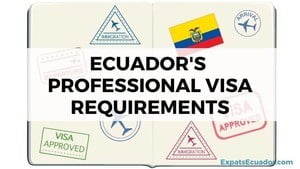We're getting to your messages. Thanks for your patience🙏
Ecuador is one of the most attractive options in all of South America for investors looking to relocate temporarily or permanently. Not only is it a dollarized country but it is also a country with wonderful landscapes, a unique and diverse gastronomy, and friendly people.
It also has one of the lowest investment amounts to unlock residency visa options with a low cost of living.
Let's explore why the investor visa is one of the most popular visa types for Ecuador.

The Temporary Residency Investor Visa is a popular option for foreigners looking to migrate to Ecuador. This visa type requires providing funds to Ecuador's economy. Be it through buying a property, a Certificate of Deposit in a bank, or starting a business, you'll need to invest a minimum of $46,000.
You can also obtain a Permanent Residency Visa after fulfilling two years as a temporary visa holder.
For those seeking not just a serene place to live, but also a haven for their savings, Ecuador stands out with its attractively low cost of living. Imagine having the opportunity to reside where the economic pressures are as gentle as the Pacific breezes - this is the reality Ecuador offers.
A comparison with the United States paints a clear picture: a cozy one-bedroom apartment nestled in the vibrancy of an Ecuadorian city center may cost up to 74% less. Groceries, transportation, and leisure - essentials for a fulfilling life - are notably lower in price, presenting a welcome contrast to many expats and investors.
This significant financial relief is a key motivation for many contemplating a life amid Ecuador’s charms, whether retirees stretching their pensions or savvy investors maximizing gains.
This visa allows you to stay in the country for 2 years and can be renewed. Those looking to advance to permanent residency are limited to spending less than 90 days outside Ecuador during their temporary residency.
For those not currently seeking permanent status or citizenship, continuous presence in Ecuador is not mandated, giving you more time to explore other countries.
Here is a breakdown of the possible expenses involved in your application:
Any of these prices may vary, for now, the price of visas and applications is stable, but you should always be aware of changes. A professional facilitator will be able to help and guide you throughout the process, they may have valuable contacts and your application will have a higher chance of being approved.
The process of obtaining a residency visa is detailed and requires applicants to meet general requirements meticulously.
1. Valid Passport
At least 6+ months, my personal recommendation is that it be at least two years because this way you will save yourself a problem or expenses if you decide to renew your visa or apply for permanent residence.
2. Police Record
When embarking on the exciting journey towards obtaining an Investment legal Visa status in Ecuador, it's essential to be thorough with official documents, and that includes conducting mandatory background checks. These checks are a cornerstone of the application process, ensuring that prospective residents meet the safety and security standards set by Ecuador. If you are from the United States you will need an FBI and Police Record Report. Add the Police Report from all those countries where you have stayed longer than 90 days in the last 5 years.
3. Investment
The financial criterion goes beyond mere income statements. Investment in a Certificate of Deposit (CD) or real estate must meet or surpass $46,000. Such firm but fair minimum investment requirements affirm Ecuador's embrace of expatriates who are willing to trust and contribute to its burgeoning economy. Also, a minimum investment of $47.500 is required if you not using CD's way. You will need to provide: Official documents such as bank statements confirming the monthly income. Property deeds or bank certificates underscoring the investment in a CD or real estate. These documents are more than mere paperwork; they are a testament to the symbiotic relationship Ecuador fosters with its international investors.
4. Monthly Income
Prospective investors are expected to showcase not only their monetary potency but a genuine commitment to contributing to Ecuador's growth. Proof of income is pivotal when applying for your Visa. Aspirants must present evidence that they can sustain themselves with a monthly income of at least $460. This figure is gracefully aligned with the Ecuadorian minimum wage, ensuring that foreign nationals live comfortably while respecting the local economy's standards.
5. Birth/Marriage Certificate
In case you or a member of your family needs to apply for a dependant visa you have to show your family bond.
6. Optional
Immigration Certificate from Ecuador. It depends on which office you're applying to or if an officer asks you for extra things.
Note: Documents not originally in Spanish must be translated and notarized. This is a vital step in ensuring that all your paperwork is in order.
This is a tricky one. Some migration offices will request that you have it and others may not. Either way, we do generally recomend having either private health insurance or public (IESS) to ensure your health is covered whilst in Ecuador. You can get a a health insurance quote here.
If you also want to include a family member on your application, they can only be up to the second degree of consanguinity. Let's explain this:
In order for a dependent's application to be accepted, the visa holder must demonstrate an additional income of $250 for each applicant and demonstrate their legal ties as part of the requirements.
Example:
John has a temporary residence visa (any type) and wants his wife Kathy to apply for his visa as a dependent.
John's requirements must include an extra $250 per month to what is already required according to the type of visa he has. Kathy must present John's bank statements and must also present her Apostilled and translated marriage certificate to verify the relationship.
If John also wants to add his son Sam as a dependent, then John must show an additional $500 in his monthly income (covering Kathy and Sam's expenses) and Sam's birth certificate.
Determine your application method. There are currently two ways to apply for visas in Ecuador. The online option and the in-person option. The online option is new and as of writing we aren't sure how efficient the process will be. The Ecuadorian government doesn't have a strong track record of implementing digital projects like this, but we hope the process is user friendly and works.
The other option is to the physically apply at any office of the Ministry of Foreign Affairs and Human Mobility in Ecuador.
We suggest evaluating which is best in your circumstances.
Once you have all the documents in order, you must attach them to the application documents or if a digital application is more suitable for you, then you will need to upload all the documents in PDF format. In either case, you must pay the amount relevant to the application. Check the costs here.
You must not forget that all documents must be translated and apostilled or legalized as the case may be. If you still have doubts about Legalizing or Apostille, then you can check this link. If your country appears on the list, then the Apostille will be accepted. If it does not appear on this list, then you will need to Legalize it at an Ecuadorian Embassy or Consulate in your country of origin.
After submitting your application, you will have to wait 2-3 weeks for approval. In many cases, it happens on the same day.
Once your visa is approved, you will receive a notification by email, and you can pay for the visa at the designated Government Bank or online if you have completed the process through that means. Taking care of the rest of the steps is very important so that you can make sure you do not repeat some important procedures, such as obtaining an Ecuadorian identity card.
Obtaining the official document to request and process your identity card is essential. Once you obtain this document called "Orden de cédula" you can go to a Civil Registry office and finally obtain your document. You can use this within the country and it will allow you to open bank accounts, obtain invoices under that number, register in the Internal Revenue System of Ecuador (Taxes), and many other benefits such as enrolling in the Social Security of Ecuador.
The certificate is a document issued by the bank where you chose to deposit your money. The investment amount must be at least $46,000 as of 2024. This amount will be retained for 2 years and will accumulate interest. These interest percentages depend on which bank or co-op you choose, for example, Jardín Azuayo offers 8.75% accumulated interest, and the JEP Cooperative 8%. This means that over the life of your investment, you will withdraw at least $5000 more than you originally invested.
Opening an account in any Cooperative involves paperwork, additional documentation, and of course proving that your money is legal. A visa specialist can help you in the process, advise you, or even sometimes recommend someone who works directly with the bank to make your process much easier and faster.
Buying real estate is a popular pathway towards this visa. The assessed value of the property must be at least $46,000. You will need to provide the deed and other property documents as proof of ownership.
If you're looking for real estate in Cuenca, you're welcome to reach out to the YapaTree Properties team and they'll look after you.
After successfully obtaining your Ecuadorian Visa, you are granted temporary residency in Ecuador. This residency allows you to live, work, or study in the country for an initial period. After living in Ecuador for a certain period, typically 21 months, you can apply for permanent residency.
Benefits of applying for permanent residence
Typically, the process may extend to a few weeks or months, depending on various conditions, among which thoroughness and correctness of the submitted documents are paramount. After making the requisite investment, applicants can anticipate a waiting period that allows authorities to vet and approve the application for this type of visa.
Certainly, the prospect of obtaining an Investor Visa yourself is possible. With investment options varying from a title or certificate of deposit in an Ecuadorian Financial entity, to acquiring real estate or investing in company shares with distinct minimum values, self-application requires an understanding of the Ecuadorian legal framework.
However, proceeding without professional guidance can be daunting given the intricate legalities and specific requirements such as proving the authenticity of documents or meeting the Ecuadorian minimum wage multipliers for investment. Many opt for an immigration attorney or a visa specialist to eschew common pitfalls and ensure the process is as smooth and efficient as possible. Feel free to reach out for a recommendation.
As with any immigration pathway, the road to an Ecuador Investment Visa may have its hurdles. Common reasons for application denials include administrative oversights such as incomplete forms, incorrect investment amounts, or failure to submit the mandatory official documents with the proper apostille or legalization.
Another factor could be changes in personal circumstances that alter dependency status, such as the dissolution of a marriage. Thus, it's paramount to fulfill all requirements with assiduity and a firm grasp of guidelines for each type of visa, particularly when it pertains to minimum investment and income stipulations.
Ecuador is widely regarded as one of the best places to choose to retire. It has one of the most organized migration systems in the region, and every year updates and improvements are generated around the migration policies it manages.
The newest change expands the electronic process to include online visa applications, further positioning Ecuador as a leading country in the region to welcome new residents from all over the world.
Recently, the government has updated the visa application process to include more online options.
Until July 5th, 2024, Ecuador processed all its visas with physical documents in the various offices of the Ministry of Foreign Affairs and Human Mobility, from requesting an appointment to going to the office and waiting for a response, which could take around 30-45 days.
Thanks to the recent update, all visas can now be applied through the Ministry's virtual platform, so you can obtain a digital visa from anywhere in the world, making this process much more agile and faster. In the digital era, e-visas introduce an elegant, efficient, modernization to the age-old practice of travel documentation.
Through e-visas, Ecuador's hand of approval is nothing more than a series of precise forms, necessary attachments, and the silence of anticipation before the arrival of the email: the modern welcome reel. Ecuador's application process is now an invitation to the world: come, stay, contribute, and prosper within our borders, respecting the structured path to residency as a dance of responsibility and opportunity.
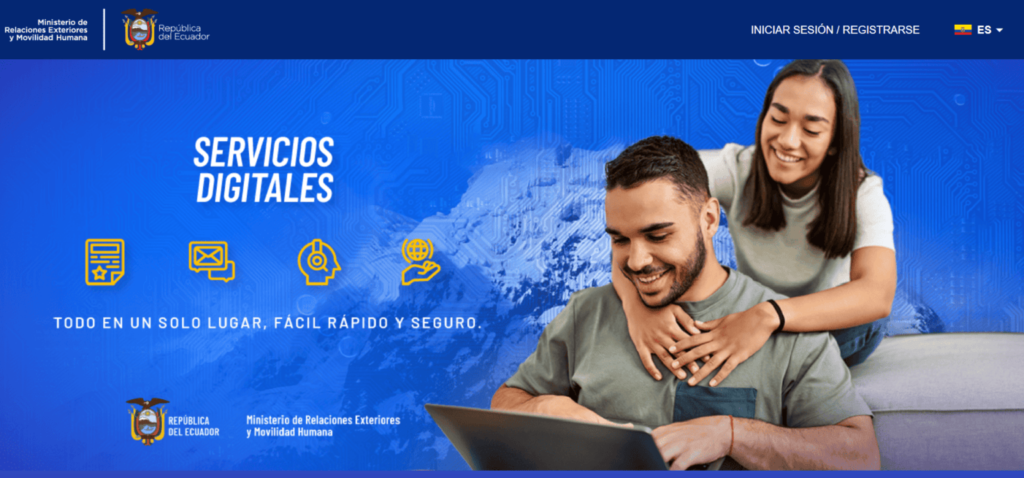
Although 2024 brought various changes to the visa application process, Ecuador still preserves the same requirements for each of the various types of visas,
With an array of temporary resident visas, including Professional, Investor, Pensioner, Rentista/Digital Nomad, and Dependent, Ecuador extends a warm welcome to future residents from different walks of life. These visas, each catering to specific circumstances and qualifications, enable foreigners to live, work, study, or retire under the Ecuadorian sun for up to two years, with eligibility for renewal.
After holding temporary residency for at least 21 months, with limited time spent abroad, one can seamlessly transition towards applying for permanent residency. This pathway represents Ecuador's recognition of the profound connections that can be formed with the land and its people over time.
Moreover, the government has streamlined the visa application form, ensuring the entire process is more accessible and less daunting for applicants. The vast majority of temporary visas, such as the popular Work, Student, and Retirement visas, not only facilitate engagement in respective endeavors but also truly embed individuals into the community fabric of Ecuador.
The following documents need to be included when applying for any temporary residency visa:
A noteworthy aspect of the visa process is the synchronization of one's passport with the electronic visa system. Given that your passport number is a crucial anchor for visa issuance, mindful planning around passport expiration dates is essential. If your passport is set to expire within the 2-year visa duration, it is prudent to renew it beforehand to avoid any disruptions. Should a passport renewal be necessary post-visa application, a fee of $100 and a return trip to the visa office are required to ensure a smooth transition of the electronic visa to your new passport number. This shift to electronic visas reflects Ecuador's dedication to modernizing its systems, prioritizing convenience for applicants.
Ecuador's permanent and temporary residency visa requirements mandate health insurance for everyone embarking on this journey, excluding those on a short 90-day tourist visit. This prerequisite ensures that all are protected during their stay. Whether opting for private health insurance, approximately $100 per month, or awaiting the opportunity to join the public health system upon cédula acquisition (IESS), this requirement helps ensure sustaining well-being while in Ecuador.
Financial stability is key to thriving in a new environment, and Ecuador's income requirements for visas reflect a reasonable and approachable threshold. Depending on the visa type, the minimum monthly income requirements range from USD 460 to USD 1380.
Lastly, Ecuador's diligence with safety is personified through meticulous background checks, signaling respect for the community's integrity. The process, while thorough, taking approximately 2 to 3 months including apostille, translation, and notarization steps is a demonstration of Ecuador's commitment to ensuring the safety and security of its residents.
In my experience, yes, it will still be necessary for many applicants to have outside assistance because the requirements remain the same and the only thing that changes is the method of applying. You still need to understand each requirement and this automated process potentially removes some of the quick, personal feedback you'd receive from a migration agent if applying in person.
A professional will be able to guide you through the process and ensure that everything is in order and that you can have a positive result.
If you have patience and aren't under time pressure and are ok with potentially repeating the process until you get it right, then it may be worthwhile considering the DIY approach.
Ecuador is a country of allure for a wide array of individuals, from retirees seeking a sanctuary with a low cost of living to investors ready to tap into potential opportunities in a market that operates in US Dollars.
Temporary residency visas bless foreign nationals with the freedom to dwell for two years, along with the liberty to roam outside the country for up to 90 days annually - a perfect blend for those who wish to balance their time between homelands.
Ecuador's visa portfolio is bustling with variety, just like its vibrant culture. Tourist visas for visitors, temporary and permanent resident visas, work and student visas for professionals and scholars, and retirement visas for those looking to unwind.
For a smooth experience, remember to check the most recent updates on the type of visa process when planning your journey to ensure compliance with the Ecuadorian consulate guidelines.
Can I apply for a visa to live in Ecuador if I am outside of Ecuador?
You can, you just need to get advice to know what type of specific documents you require. Although the virtual platform provides information on the requirements, you must make sure of the exact format in which the documents must be provided.
If I travel to Ecuador as a tourist, can I apply for a visa while there?
Yes, you can apply for a temporary visa as long as you are still legal. Make sure you have enough time on your tourist visa.
Are visa prices still the same in Ecuador in 2024?
Yes, they remain the same, until now the government has not issued any information on price updates.
If I obtain my visa through the new platform, will I still need to go to an office to obtain my ID?
Yes, the in-person ID-obtaining processes remain the same. A visa facilitator will be able to help you follow the entire necessary process.
If you have a remote job with a contract, Ecuador’s “Digital Nomad Visa” is now an attractive option.
Neil Olsen, the Minister of Tourism, proposed that the Ministry of Foreign Affairs create a ‘Nomad Visa’ in 2021. There were some teething issues, but this visa type has now become a viable option.
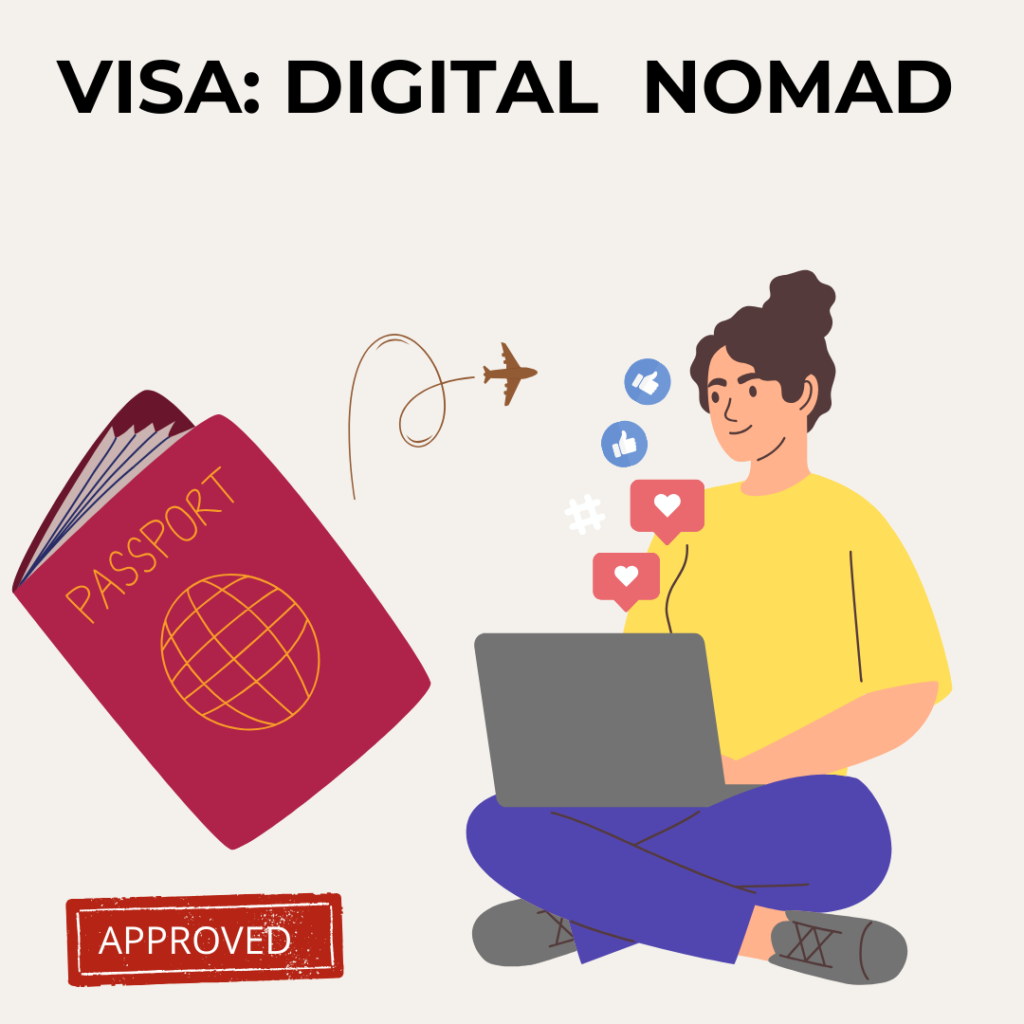

- No income stuck in investments
- No education requirement
- Flexibility to spend time outside of Ecuador
CONS
- It is not an option for those who do not have an employment contract.
- Relatively new visa requirements may be variable or confusing.
Digital Nomad Visa Requirements:
Digital Nomad Visa Costs:
This visa is relatively easy to apply for. Many friends who work remotely have successfully obtained this visa. One of the main difficulties has been ensuring the Ministry accepted their employment contracts.
Also, I’ve seen issues with the Ministry accepting the modality letter. You can apply for the visa yourself, or you can hire someone like Expat Law Group to assist with the process.
The income must be in your bank account and the minimum monthly income amount is currently $1380. Just note that this value is pegged to Ecuador’s basic salary, which tends to change slightly each year.
Proving your bank income is straightforward. It is one of the only documents that does not need to be apostilled, you just have to download it from your computer.
Are you a digital nomad and have your own business?
This is perhaps still the most frustrating part of applying for this visa. Because the visa is still relatively new, the Ministry may apply a strict interpretation of the laws and deny your application.
However, it is possible. You must prove some additional requirements like you are the owner of a registered company.
But what happens with the employment contract and the Modality Letter?
One problem that seems to have gone unnoticed is that it can be weird having an employment contract in your name (as the employer) with yourself as an employee. I don’t know many digital nomads who treat themselves as their own employee.
If you fit into this category, I suggest looking at the Rentista or Investment Visa categories. These have the same income requirements, but can be easier for your application to be accepted.
In short, this visa has many positive sides for remote employees. Ecuador remains a popular digital nomad destination due to its low cost of living, abundant coworking options, and numerous hiking and other outdoor adventure options.
Are you a digital nomad in Ecuador?
Feel free to join our Digital Nomad Ecuador FB Group. Or, if you need help with this or any other visa, consider using someone like this.
Related articles:
Main image: Clave.com.ec
Editor's note: This article has been contributed by our friend, Ian. Whilst this guide specifically focuses on how to extend your tourist visa in Cuenca, it's a very similar process if applying at other migration offices around Ecuador. You can download the extension application form.
Ian originally submitted this article in 2021, it has been updated to reflect new requirements, particularly the costs and when you can apply for the extension.
===
Ecuador may not be a big country but there is plenty to see. With beautiful cities, mountains, jungles, and beaches, 90 days in Ecuador may just not be enough to see it all. But did you know how easy it is to get a visa extension in Ecuador?
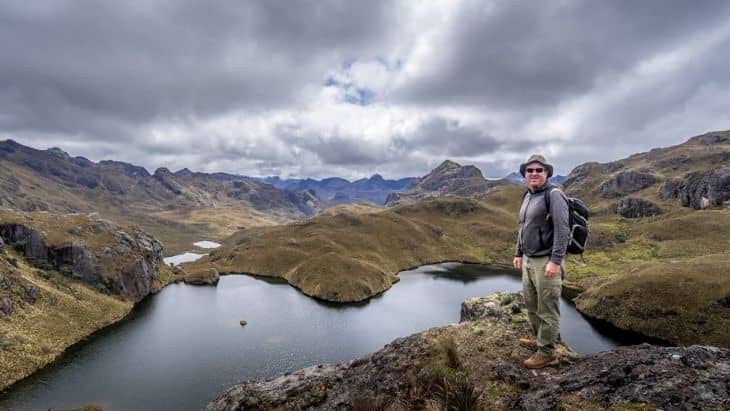

Well, don’t worry. For a small fee and just a little paperwork, the Ecuadorian government will let you stay for another 90 days if you wish.
As I had been enjoying Ecuador so much and traveling rather slowly, I decided I was going to get a visa extension in Ecuador for another 90 days. I happened to be in the city of Cuenca when my 90 days were up. This turned out to be a great place to take care of things.
Related Video from YapaTree
I will walk you through the process of how to get a visa extension in Cuenca. But I can’t guarantee it will be this easy everywhere. To be honest, if you have survived 90 days in Ecuador already then you are probably smart enough to figure out this process without too much help.
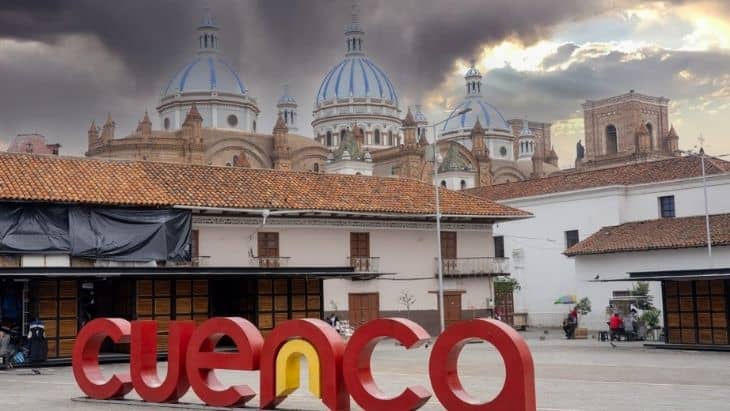

If you can speak Spanish, a quick visit to the government of Ecuador's website will tell you most things you need to know. The most important thing on this page is the list of immigration offices that you can go to, to extend your visa.
Supposedly you can extend your visa online, and also download the paperwork you need on this site. When I applied for my extension, neither of these features were working. As long as you are not staying too far from an immigration office, I think a quick trip there is probably the easiest way to take care of things.


My closest immigration office was at the airport in Cuenca. This was an easy bus ride from the house I was staying at. If you are staying in downtown Cuenca, the Tranvia will drop you right at the front door for only 1 USD. You can even walk there in about 30 minutes or just a 5-minute walk from the main bus terminal.
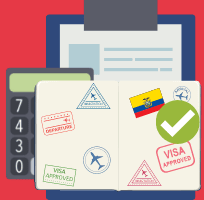

When to extend your visa?
One of the important changes made during 2023 was the ability to extend your visa during days 80 and 90 of your current visa/tourist stamp. If you exceed 90 days on your original entry, you can expect a fine on top of your extension fee.
Tip: Be weary of holidays - the migration offices close but they still count these as a day, even if you apply online.
The previous rules forced you to apply for the extension only after your 90th day of being in the country. Yes, you were technically irregular when you applied for your extension. This always felt weird and I’m glad they’ve changed it.
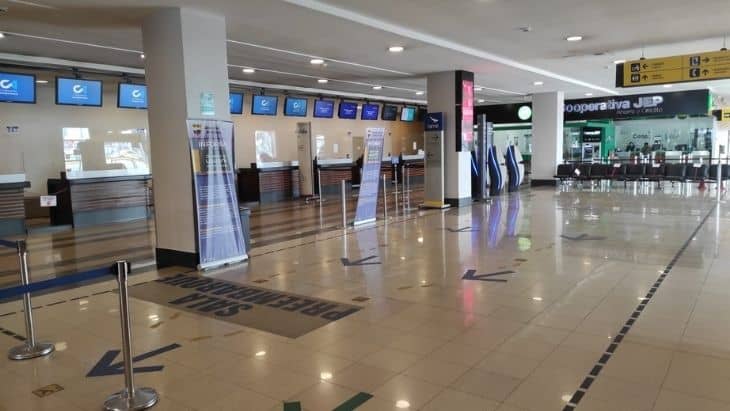

The lady at the counter was kind and helpful, the immigration office will provide you with all the information you need to apply:
The lady gave me the correct form to fill out. It is such a simple form you may not find it worth downloading and printing ahead of time.
To obtain the color copy of my passport, she directed me to one of the restaurants in the nearby food court of the airport. Lomos Restaurant has a copier under the counter and will give you a color copy for just 50 cents.


The most helpful part of visiting a day early was that she gave me a payment slip for the bank. She filled out all of the details for me and gave me the address of the nearest bank.
You can make the payment at any Banco del Pacifico. But I chose to pay at the one she told me was closest. The current fee it's $153.33. Why this amount you may ask? It is based on the minimum wage in Ecuador and the fee is a third of that amount.
The lady was very, very specific in that the fee must only be paid on the same day that you plan to extend your visa. Do not go into the bank and pay the day before!
So on my application day, I headed back into El Centro. I headed straight to the Banco Del Pacifico that I was told about. It is about a 15-minute walk from the airport, or a quick Tranvia or taxi ride if you prefer.
Now if you have been in Ecuador for more than 80 days already, then you have probably noticed the huge lines outside the banks every day. I showed up, fully expecting to be waiting for an hour or more in one of these lines. Well, I was pleasantly surprised. Shocked. No line at all! I was directed straight to the counter. The bank teller knew exactly what I was there for. Within a couple of minutes, I was walking back to the airport to get my visa extension.
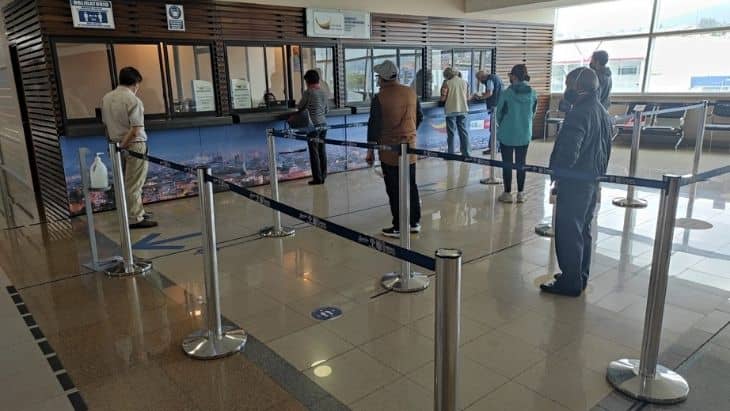

The immigration office is on the second floor of the Cuenca airport. It’s just to the right of the stairs leading up there. Cuenca airport is very quiet and you should have no problem finding it.
It is open Mon – Fri from 8 am to 5.00 pm. Both times I visited, I walked straight up to the counter with no waiting.
The lady at the counter remembered me from the day before. She took my passport, completed form, color copy of my passport, and the bank receipt. Within less than 5 minutes I was out of there with another 90 days in Ecuador in my hand. Getting a visa extension in Ecuador really is that easy!
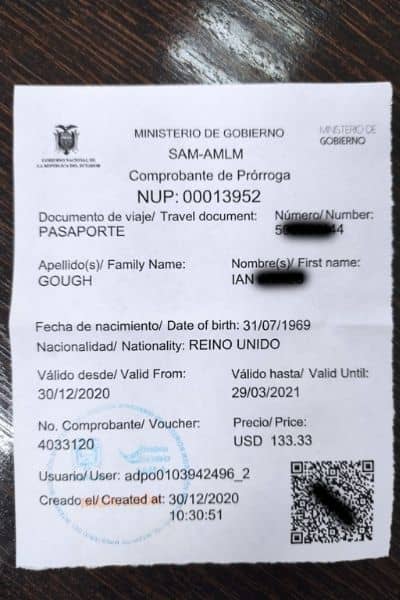

Your visa extension just comes printed on a piece of paper. Nothing is actually put in your passport. Be careful not to lose this expensive piece of paper.
Also, remember that time doesn't stop if you leave the country and re-enter with this extension. This is different from your original 90-day tourist visa/stamp where time does stop if you leave the country. Once your additional 90-day extension expires, you'll either need to apply for a temporary residency visa or leave the country and re-enter one year after your original entry date.
What about the current process in 2024?
How many days do you have to apply for your extension in case you exceed 90 days and how much do you have to pay for the fine?
Maximum to 120 days, for applying your extension, and you will pay the fine of $230 (50% of the current salary) + the extension of $153.33, in the end, you will need $383.33.
If you exceed day 120, then you will receive a notification to leave the country in a maximum of 30 days, sometimes they inform you if you can come back next year or if you have to apply for a temporary visa before you arrive on your next trip to Ecuador.
My best recommendation: Be aware of the number of days you have left, you don't want a headache and an unnecessary extra payment.
How was your experience extending your visa in Ecuador? Was it as easy as mine? Did you do it in a different city. Let me know your experiences in the comments below.
It feels like we're still catching our breath from Ecuador's 2021 visa updates. President Guillermo Lasso made numerous changes to Ecuador’s visa requirements in 2022. The new President Daniel Noboa is yet to make any substantive changes.
The last updates received before Daniel Noboa became official president were:
1. April 2023: Update on consular prices (new, lower visa prices).
2. June 2023: Update on the regulations for tourist visas.
It appears as though Ecuador has decided to substantially increase monthly income requirements for the Retirement & Rentista visa categories.
$425 per month (was the basic salary at that time)
Now (2024) it's $460.
$1380 per month (with the current basic salary 2024)
Both the Retirement & Rentista income requirements were previously based on 1 basic salary (be sure of the current salary). We're not sure why, but these have now been upped to 3 basic salaries (which currently equals $1380).
We did get some indication that the income requirements for the Rentista Visa might be updated. During conversations about the much anticipated Digital Nomad Visa, it was revealed that this visa would most likely be created under the Rentista Visa category. And, the income requirements were to be 3 x basic salary.
But, applying the same income requirements to the Retirement Visa category was a complete surprise to everyone in the visa industry (including us). President Lasso's campaign promise was to increase the basic salary to $500. This hasn’t happened, but the current president, Daniel Noboa, increased the income requirements to $460 in January 2024. So, the monthly income requirements automatically increased to $1380.
Whilst I seem to be in the minority, I was always hesitant to heap praise on the Digital Nomad Visa because it may set the income standard for other visa types. This looks like what's happened.
The powers that be have decided they want to only attract retirees who can afford to live like upper-class Ecuadorians. Only a small proportion of Ecuadorians (& certainly not retirees) can prove they earn over $1380 per month. 50% of Ecuadorians live off less than $500 per month.
The Retirement Visa income requirements seem to be bouncing around with no real indication of why. They were reduced from $800 to $425 in 2021, but have now gone the other way with this most recent increase to “at least” 3 current basic salary ($1380 in 2024). Who knows what they will be in 2025! It's this uncertainty that effectively prevents lots of wannabe expats from seriously considering Ecuador as their retirement destination.
I've seen some commentary welcoming the move to increase the income requirements to $1380 as this is more in line with what many expats actually spend whilst living in Ecuador.
I disagree with this line of reasoning. Income requirements for a visa have no bearing on the actual cost of living. Many use cases will fall through the gaps.
For example, I know many expats who have multiple income sources which can be difficult to prove. These expats may fall under the $1380 limit when providing income, but they can still live a very comfortable life. Ecuador no longer welcomes these potential expats and I can't see this as being positive for the Ecuadorian economy.
Internal data from our partners on current Retirement Visa applications suggest that around 40% of applicants don't meet the new $1380 monthly income requirements. This is a sizeable chunk of the expat market, which I'd expect to have trickle-down effects on many businesses in Ecuador
We can only speculate on the political motivations behind tripling these income requirements. One plausible theory is that it's mainly aimed at ensuring Ecuador's neighbors, particularly Venezuelans, find it difficult to migrate in mass numbers.
It's not just the income requirements for the primary visa applicants that have received an overhaul. The income requirements for dependents across several visa categories have also been updated. The monthly income requirements for dependents now look like they will be:
They are further decreasing the pool of eligible expat families that can call Ecuador home. For example, the total income that a couple applying for a Rentista Visa (one main applicant + one dependent) is now $1630 + $460 income from the dependent from the month before applying. This seems very out of touch when you consider how much local couples tend to make.
The inevitable result is the income gap between expats and locals will increase even more. This doesn't normally bode well for lingering tensions between the two communities.
We got our 1st look at Ecuador's Digital Nomad Visa and I have to say I'm a little disappointed. Let me explain.
Article 64 of Decree 354 indicates that the Nomad Visa is still subject to the 'essential requirements determined in the law'. These essential requirements are outlined in Article 58; including the following:
"Certificate of no criminal record from the country of origin or in which he/she has resided during the last five years, duly translated into Spanish and, if applicable, apostilled or legalized, as appropriate. For these documents one hundred eighty (180) days of validity will be taken into account, counted from the date of issuance of the certificate until the last entry of the interested party to the country."
Yep, the Digital Nomad Visa will still require a background check that is also apostilled. I personally had discussions with the Ministry pushing for the Digital Nomad Visa and they made it clear they wanted to make this visa as easy as possible to obtain. The trade-off was to be the increased income requirements.
I'm comfortable arguing that this background check requirement (complete with apostille) destroys any hope that this visa will be easy for digital nomads to obtain. The background check component is generally the most time-consuming and expensive part of the visa process.
The reality is that the Professional Visa is going to be a much better option for most digital nomads now. This visa survived any substantial updates and the income requirement is at least 3 basic current salary each month (1380 USD) , for the last 3 months before application. Another important document is the contract, your company has to make sure to describe your position as a completely “remote job”, and provide your salary information (it should be $1380 or more each month), So, if you have a degree (associate or higher), then I suggest sticking with the Professional Visa and not bothering with the Digital Nomad Visa.
One of the most frustrating legacies of the 2021 changes is still not clear. That is whether those currently on a temporary residency visa could leave Ecuador & still be eligible for permanent residency.
The Azogues Migracion Office took a closed stance and was denying permanent residency visas if you'd spent even one day outside Ecuador during temporary residency. However, some other offices took a wider stance and were approving permanent residencies for applicants who had spent up to 89 days outside of Ecuador during temporary residency.The 2022 visa updates do address this and I have my interpretation of the new law. But, I need to wait until each office provides its interpretation before I'm comfortable providing this to you. My money is on another non-uniform interpretation between the offices, but let's hope this doesn't eventuate.
Update: Now, in 2024 they still check how many days you spend outside Ecuador, but I recommend not leaving the country for more than 80 days for the first 2 years with your temporary visa, then you can apply without problems.
We'll provide a more comprehensive round-up of these changes once it's clear how they are interpreted. I know this is a very stressful time for applicants currently going through their visa process. My thoughts go out to you and hope these updates haven't destroyed your plans of calling Ecuador home.
Feel free to reach out to us if you have any questions. We can try to answer them or put you in touch with a visa specialist that can.
Ecuador is one of the easiest countries to obtain a long-term visa. There are multiple pathways to residency and the investment is relatively low.
After reading this guide you should have all the Ecuador visa information you need to decide whether Ecuador is a viable long-term option for you.
You may even have 2 or 3 different residency visa options open to you. Once you've read this article, we suggest checking out our Ecuador Residency Visa Calculator to give you more insight into your visa options.
Please note that visa requirements for Ecuador change frequently and these changes are not always well-publicized (if at all). So, it's always best to check with an immigration lawyer or a visa facilitator first.
Let's touch on some basics visa facts:
Citizens from most countries, including the US, Canada, UK & Australia, do not need to obtain a visa prior to entering Ecuador as shown by the following map:
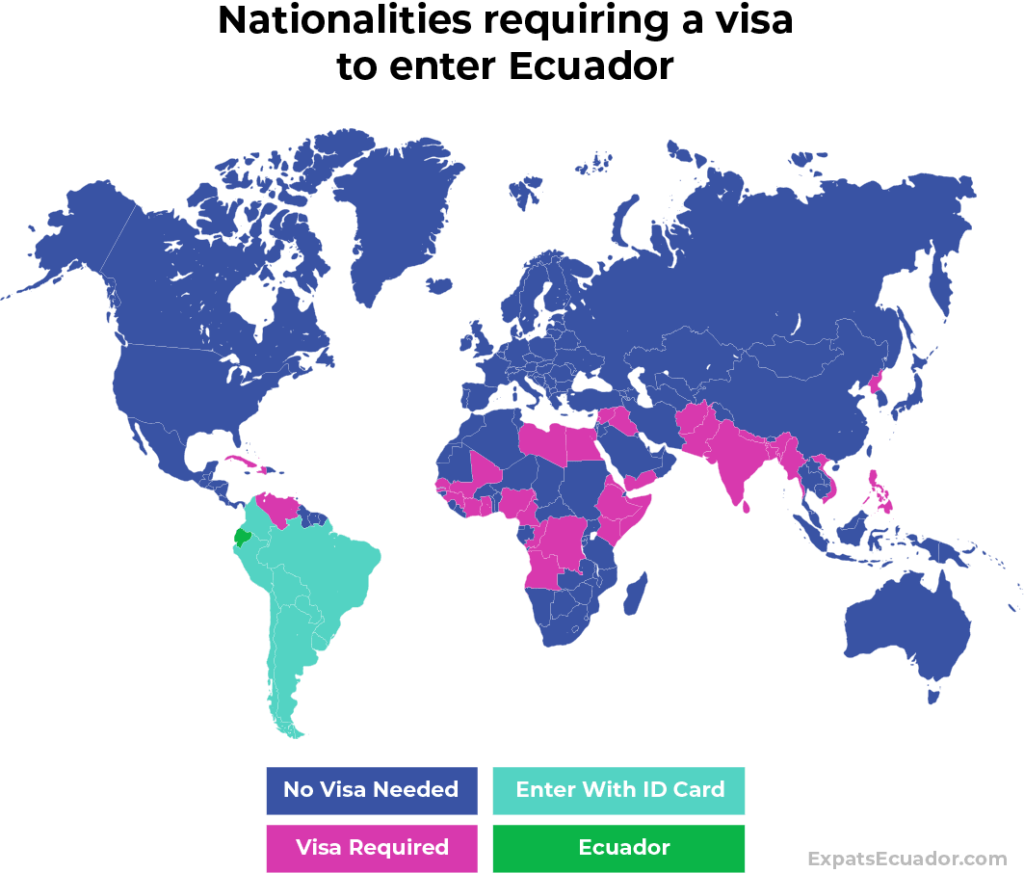

Nationals from the following 34 countries require a visa:
| Afghanistan | Angola | Bangladesh | Cameroon |
| Congo * | Cuba | DRC | Egypt |
| Eritrea | Ethiopia | Gambia | Ghana |
| Guinea | Haiti * | India | Iran |
| Iraq | Ivory Coast * | Kenya | Libya |
| Mali * | Myanmar * | Nepal | Nigeria |
| North Korea | Pakistan | Philippines | Senegal |
| Somalia | Sri Lanka | Syria | Venezuela |
| Vietnam | Yemen |
* Added on May 17 2021 (source)
Nationals from countries that do not require a visa can be issued a tourist stamp on arrival. This is valid for 90 days within a rolling year. Those 90 days do not have to be used consecutively.
This does confuse visitors, but it's relatively simple. Unlike many countries that use a calendar year, Ecuador uses your date of entry as the start of your 365 days.
For example, say you enter Ecuador on May 20, 2024. Then, you're allowed to stay 90 days until your year finishes on May 19, 2025. Here it's called chronological year. Be sure to check it in the immigration office, sometimes they stamp something in your passport, and then in the system they have another different day, one more or less.
You can come and go as you please, provided you haven't used up all of your 90 days.
No. Sorry. Border runs are popular in countries like Thailand and Vietnam where you can reset the number of days you're allowed to stay in the country by popping into a neighboring country and then returning.
As such, visiting Peru, Colombia or any other country will not reset your 90-day allocation.
Yes, you can extend for another 90 days relatively easily. After that, you can potentially even extend for another 90 days, you must request the extension between days 80-90 of your tourist visa, the extension has a cost of 153.33 USD, but if you request the extension after day 90 and before day 120 you must pay a fine.
The main types of residency visas popular with expats are:


We've broken down each visa type, including the requirements and costs below.
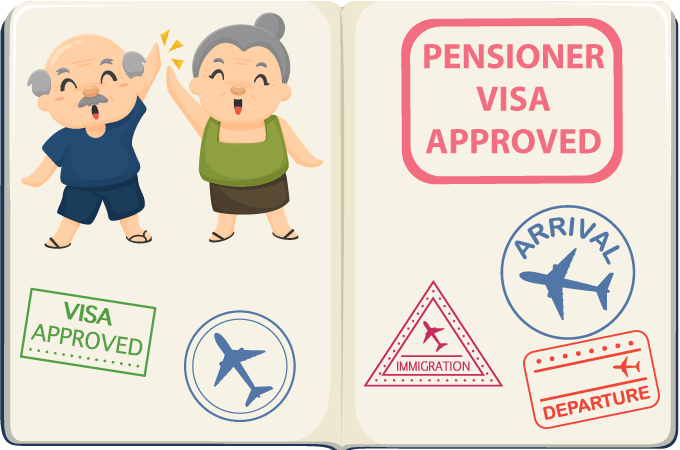

Ecuador's Pensioner Visa (or Retirement Visa, Pensionado, Jubilado) is the most popular type of visa for retired expats wanting to spend their golden years in Ecuador.
The main requirement is that you receive a guaranteed income for life. This is most often satisfied via regular social security checks, but it is not limited to this income source only.
You can also have income from other guaranteed sources such as pensions, annuities, superannuation, etc. But, the main point is that the income must be guaranteed for the remainder of your life.
If you are using Social Security, then you'll need to obtain an official letter from the Social Security Administration. This also needs to be signed and apostilled.
Dependants can also be included on a Pensioner Visa. This includes spouses, children, and grandchildren. However, this can be risky because it's tied to the primary visa holder. If something happens (i.e. relationship breakdown), then the dependents need to apply for their own visa(s). In the case of the death of the dependent, it is different, the dependent has 30 days to notify the Ministry and deliver the death certificate. Otherwise, you will lose your immigration status.
The law was changed in March 2023 to make this visa even more attractive. They reduced the amount for the application to $270. You will need the additional $200 income requirement for each dependant.
This makes Ecuador one of the most expat-friendly destinations for retirees wanting to maximize their social security.


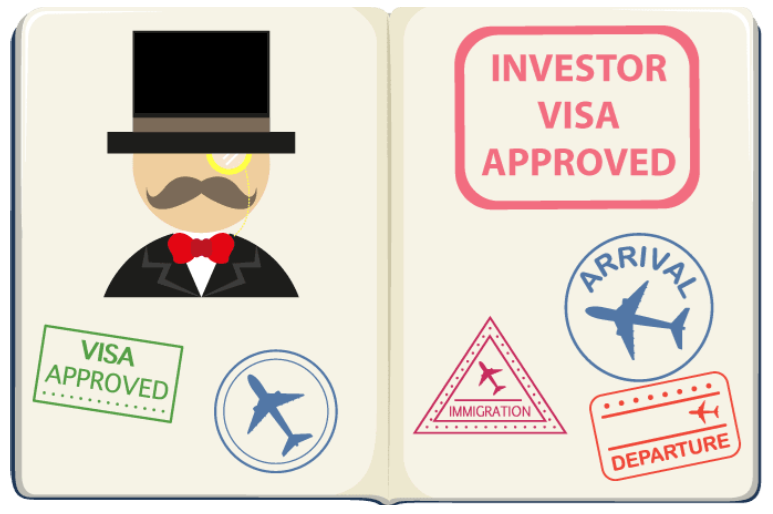

Low investment amount of $46K
More flexibility to spend time outside of Ecuador
High CD interest rates of 8-9%
Property investments also count
$46K is tied up for the duration of your visa (2 years)
Hard to get money out of CDs (or property) if needed
But a good advisor can help you by resolving these doubts.
Ecuador's Investor Visa (or Real Estate Visa, Inversionista) is popular amongst expats that don't receive social security benefits.
The two main pathways are:
There's also the possibility of other investment options such as investing in an Ecuadorian business, but we're going to only focus on the 2 popular pathways listed above.
This is generally the preferred option because it's a whole lot easier and less risky than purchasing a property.
The best part about Certificates of Deposits (CDs) in Ecuador? The high interest rates of course. The most popular banking option in Cuenca (JEP) currently offers 8% as their standard rate. Obviously, the rate changes, but you should expect significantly higher interest rates than in the US etc.
Of course, all investments carry risk and this one is no different. Many banks and cooperatives that offer CDs do have protection up to $32,000. But, as the minimum CD amount is $46,000 this still leaves $14.000 unprotected if something does happen.
And no, you can't mix and match your CDs at different institutions in an effort to ensure all the $46K is protected. It needs to be one CD.
You can't touch the principal amount for the duration of your visa (i.e. 2 years initially). However, you can take out the interest or just let it compound so you have yourself a nice little bonus at the end of your two years.
ie At the end of two years @ 8% interest:
Your inversion is $46k, then the 8% will be $7360 USD. This will provide you with a total of $53.360, Your profit on the original investment is considerable. Not bad at all. Time to treat yourself to a little shopping holiday!
When setting up your CD make sure you take notice of the terms and conditions. Especially the default roll-over provisions should you want to request your money back. You'll likely have a very limited window as the term of the CD expires to request your money or you may have to wait another term. It's VERY difficult to try and obtain your money mid-term. We aren't talking about penalties for early withdrawals, it's more along the lines of "Sorry, you can't access your money. Period."
Ecuador has some of the most affordable property prices for expats. This can make it very tempting to kill two birds with one stone by buying yourself an affordable property that you can also use to obtain your Investor Visa.
However, buying property in Ecuador is very risky and not something we generally recommend unless you really, really know what you're doing & have already lived here for at least a year. A buyer’s agent service like this one can help you navigate the process with confidence.
Ecuador is a very different property market than what you're used to. It's very easy to get burnt and can be frustratingly difficult to sell.
If you do decide to go down the property path, note that it isn't the purchase price that matters. It's the assessed value (i.e. the amount you pay tax on) that needs to be over $46.000 plus an additional $200 for each dependent attached to the visa.
Other popular residency visas generally only allow you to stay outside of Ecuador for 90 days. However, the Investor Visa does not have any restrictions on how long you can stay outside of Ecuador and still maintain your Investor Visa.
This can be a significant advantage for seasonal or 'bluebird' expats who like to escape their cold North American winters in favor of Ecuador's more temperate climate.
The main caveat is that if you're considering eventually applying for permanent residency (and eventually citizenship), you don't have to leave the country for more than 90 days in the 2 years, you can start the process by the 21 continuous months in Ecuador. Then you'll be limited to a maximum of 180 days each year for the first 3 years of your permanent residency.
So, if you aren't considering permanent residency or citizenship, then it might be best for you to re-apply for an Investors Visa every two years. Yes, this will mean more paperwork and costs over the long-term, but that might be a small price for having Ecuador as your second home.
If you do decide to leave Ecuador, you should be aware of the current 5% exit tax on cash leaving the country. There has been continuous talk of removing the tax, but until it actually happens you should be prepared to lose 5% on any capital leaving Ecuador.
Now, if you've had your money earning 8% interest for two years, then you're still going to come out significantly ahead. But it's still a hit to your hip pocket.


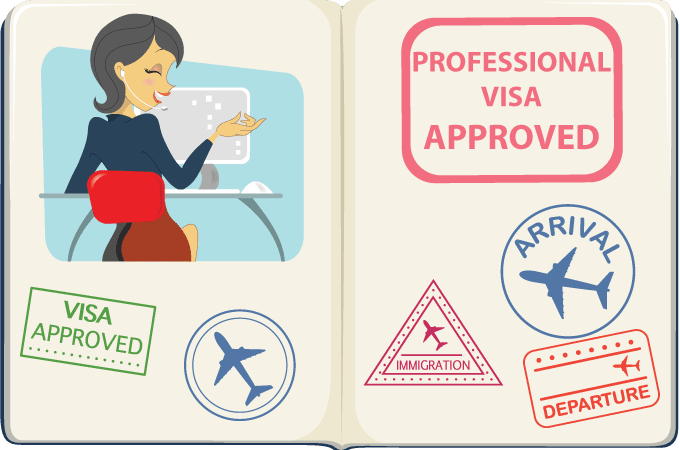

Ecuador's Professional Visa is the most popular choice amongst younger, university-educated expats. I have this visa and it's served me well.
This is a very flexible visa because the only significant requirement is that you have a bachelor's degree (or higher). The idea is that professional migrants will help the Ecuadorian economy.
You don't need any post-graduate experience in your chosen degree or work in that field in Ecuador. Nothing.
The most difficult part of the process for me was registering my degree with SENESCYT. They made me jump through numerous bureaucratic hoops before they would accept my degree.
The problem? They had issues with my Mode of Study Letter and wanted to be sure that my degree was taken in-person and not online. I did study in-person, but because I studied two degrees and my transcript didn't differentiate between them, they had a hard time satisfying themselves that the singular degree I wanted to register was taught in-person. This took many emails between my university, SENESCYT, my facilitator and myself before it was finally resolved.
The main take away is that if your visa application doesn't fit perfectly into how they want it, then you will face delays and possible rejection.
You do need to provide evidence that you're receiving more than $460 in income each month. But, printouts from your Internet banking suffice and they don't need to be apostilled, translated, or notarized (phew).
We've previously covered the requirements and process if you need more details on how to obtain a Professional Visa.






Ecuador's Rentista Visa is similar in many ways to the Pensioner Visa. The main difference is that income from the Rentista Visa does not need to be guaranteed for life.
You only need to prove that you have $1380 of recurring income from a legal source. Common sources include property leases and investments such as annuities. You may also qualify for this if you have an employment contract that continues whilst you're in Ecuador.
The evidence you provide (ie lease agreement) needs to be apostilled in your home country before being translated into Spanish and notarized in Ecuador.
Income can be from inside or outside of Ecuador.
The biggest challenge with this visa is that it's relatively new and unproven. There are a lot more applications for the Pensioner, Investor, and Professional visas. This uncertainly also means that the requirements are not necessarily consistent across each visa processing office.


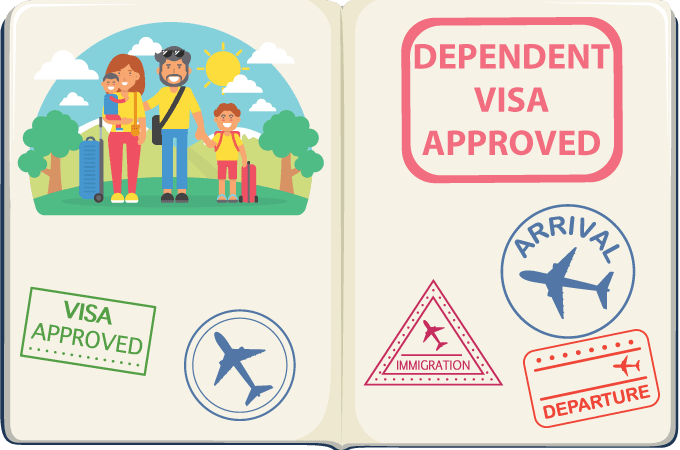

Ecuador's Dependent & Marriage Visas come under the broad category of Amparo visas.
The biggest difference with this visa is that you're pigging backing off someone else's legal residency. The three most common scenarios are spouses, children and marrying an Ecuadorian.
In the case of an expat married couple, then one person needs to qualify for a temporary residency visa (ie Pensioner, Investor, Professional, Rentista etc) and the second person applies as their dependent.
This can be very useful if the second person does not qualify for a temporary residency visa on their own. ie Perhaps you're an older married couple, but only one of you receives social security to qualify for the Pensioner visa.
You'll need to prove your married by having your marriage certificate apostilled in your home country. But, you only have 6 months from the date the certificate is apostilled to submit your application - the clock is ticking! And then it will need to be notarized and translated once you're in Ecuador.
If possible, it's generally better for each person to apply for their own visa. Why? Because if something happens to the primary visa holder, then the dependent is stuck and will need to apply for their own visa to remain in Ecuador. Not an ideal scenario, especially so given you've just been through a stressful life event. No need to pile on. You should know that if the primary visa holder dies, you have a period of 30 days to notify the Ministry, in order to give legal continuity to your visa, you should think about what your next step will be for a next visa in case you do not have the requirements. If you do not notify, your visa will be canceled and you will have to leave the country within a maximum period of 30 days.
Another common scenario is using the dependent visa for minors that are under the care of the primary visa holder.
In this instance, you'll need to provide an apostilled birth certificate from your home country and apply for the visa within 6 months. If you fail to submit within 6 months, you'll need to provide another apostilled birth certificate. Again - better to have this translated and notarized once you arrive in Ecuador.
If your child was born in Ecuador, you can go directly to the permanent protection visa, you just have to show your child's birth certificate and have all the additional documents as required by the dependent visa.
Marrying an Ecuadorian citizen won't automatically grant you citizenship. You still need to apply for a visa. The biggest difference in this circumstance is that you can skip the temporary residency requirement and go straight to permanent residency. Yay!
You'll need to provide your Ecuadorian marriage certificate or in the case of a de-facto relationship (union marital de hecho)- a certificate confirming you've registered your de facto reunion in Ecuador.
The documents and process for getting married in Ecuador is a topic for another day.
If you're all trying to apply for the residency visas together, bear in mind that you may need to have the primary visa holder's visa approved before you can apply for any dependency visa(s).
This can significantly increase the total processing time as it generally takes 2-3 months for each visa to process. So, you're looking at around 6 months total for all visas to be issued.
The additional timeframe shouldn't be a significant burden if you're on the ball and have planned ahead, but it certainly throws a wrench in any last-minute visa planning.
The visa fees for dependents are currently $200 - or half of the primary visa holder's fees. This fee is only payable once the visa is approved.
The application fee remains the same ($50).
On top of proving income for the primary visa holder, you'll also need to show $460 income (the month before application). This can be proven by printing the last month worth of bank statements from your Internet banking which does not need to be apostilled, notarized, or translated.


On top of the specific or 'special' requirements for each of the temporary residency visas included above, you'll also need to provide the following requirements that are mandatory for all Ecuadorian temporary residency visas.
Download from the official immigration site.
This needs to be completed in Spanish and witnessed by a notary.
Whilst the official requirement is that your passport is valid for 6 months, we recommend having at least 2 years (ie the duration of the initial visa). Why? Because it can be a real hassle to try and transfer your visa to a new passport and cost another $100 to transfer your digital visa to a new passport number.
This can mess up the entire process if you don't plan properly. Your background check should be completed at both the state and national level which can take time.
If you’re a US citizen you will need FBI and State police report, you must be sure that the document is issued in the same state where you obtained your driver's license.
You only have 6 months from the date the background check is issued to apply for your visa. And, you need to have them apostilled during this time too.
Then, once in Ecuador, they need to be translated and notarized.
You need to show proof of health insurance for the process. This can be private or public health insurance.
But, you'll only be able to apply for public health insurance (IESS) once you have your cedula.
So, your best option is to obtain private health insurance just before you apply. You only need your passport to apply. The cost varies on numerous factors such as age and smoking habits, but factor in about $100/month for this.
Make sure you obtain a letter from your health insurance provider stating that you're covered and the period of coverage and it must indicate that the insurance protects you for the duration of your visa.
Get this from the Immigration office for $5
On a white background. Neutral face or natural smile accepted.
You'll need to have most of your documents notarized, and those that aren't in Spanish will also need to be translated first.
There are many notaries in Ecuador and they now charge set prices for each service, but you can consult with your facilitator, they know perfectly how to do this process.
Fees for Ecuadorian temporary residency visas are:
This applies to all of the visas mentioned in this article except for the dependent visa that has a reduced cost of $200 for the visa fee. The application fee is the same at $50.
On top of the visa fees, you'll also need to pay for:
How much you're going to pay is going to depend on individual circumstances such as: how many documents you need to have apostilled, translated and notarized.
Translations and notaries are readily available in Ecuador for a reasonable fee. Budget $100+ for this.
Postage fees can also add up. If you're not aware, Ecuador no longer has a public postal service. So, you'll need to use private couriers like DHL and expect to pay $100+ to send a document.
So it makes financial sense to try and bring as many documents with you to Ecuador as you can just prior to submitting your application.
If you decide to use an immigration lawyer or visa facilitator, then you'll need to budget for this too. Fees vary by provider and some include variable costs like notarizations and translations in Ecuador.
Expect to pay around $1,000 in legal fees for an immigration lawyer to prepare your application.
There are many small steps involved before you'll receive your Ecuadorian temporary residency visa. Expect the process to take approx 4 months, but just know that there are many variables that will impact total processing time and few that you can control.
The process for applying for temporary residency is:
The short answer is yes. The requirements change often and the process itself takes around 4 months even if you've submitted everything perfectly.
If you make a mistake and your visa gets rejected, you may need to start all over again - including getting your documents apostilled once more!
I initially tried to obtain my professional visa on my own. I took two long trips to the Ministry in Quito to try and understand the requirements and process straight from the horse's mouth. Both trips were a complete waste of time for me as I was just shown the exact same incomplete information from their website. It didn't include any of the finer details I really needed to know.
So, I gave up and used an immigration lawyer that was recommended to me.
My story is not unique. Many others have had similar difficulties when trying to complete it on their own. If you want to DIY then I'd recommend only doing so if you speak Spanish at an advanced level and have experience dealing with the inefficiency and frustration of Ecuadorian bureaucracy. Even then I'd recommend having an Ecuadorian friend go with you.
My Ecuadorian partner did try to help me, but she doesn't know the immigration system and so we still needed to get legal assistance.
I chose these visa professionals. You can contact them directly here.
They’ve processed over 5,000 visa applications and I had an easy process with them.
Yes. Unlike many countries that don't allow you to upgrade from a tourist visa to a more permanent visa, Ecuador has no problems with it. I'd argue the best way to apply for your visa is whilst on tourist visa (or an extension).
Yes, you can. Just note that some of the processes will change from outlined here.
Yes. Your visa fees are reduced by 50%.
It can. Obviously it depends on the gravity of the offence and whether your explanation is reasonable. I'd definitely be engaging legal advice if you have doubts about this.
Ecuador's generous visa program is suitable for a wide range of wannabe expats. From pensioners to young professionals and even investors, there are suitable pathways for many that want to come and enjoy Ecuador on a more permanent basis.
Just do your research well (you are if you're reading this!), pay attention to the time constraints, and don't be afraid to reach out for legal assistance should you have any doubts.
Did we leave anything out? Please comment below if we have so we can update if required. We'd also like to hear about your experience applying for residency visas in Ecuador.
Ecuador provides several visa options for expats wanting to stay in the country for more than 6 months. The most popular options for obtaining temporary residency in Ecuador are ‘Investor Visa’, ‘Retirement/Pensioner Visa’, ‘Professional Visa’, 'Rentista Visa' and ‘Dependant Visa’.
Each of these visas has its own requirements and bureaucratic processes. Our article on Ecuador's visa requirements provides an overview of the different visa types, but today we’re only focusing on the Professional Visa requirements for Ecuador.
Before diving into the details of applying for a Professional Visa, let’s take a minute to discuss your options before you need to apply for a temporary resident (migrant) visa.
Visitors from most countries (incl US, CAN, AU, EUR) can visit Ecuador for the first 90 days on a Tourist Stamp obtained upon entry. Residents of 34 countries need to obtain a permit prior to entry.
Once your initial 90 days are up, you can then get a ‘Tourist Visa Extension’ whilst in Ecuador for an additional 90 days. Bringing your total stay in Ecuador to 180 days. New regulations were introduced in 2024 to apply for the tourist visa extension. Be sure to apply for the extension when you are between day 80-89 of your tourist visa. A facilitator can make the process easier if you need this help and the rules do change a bit.
After the initial 6 months, it used to be possible to obtain a ‘Special Tourist 6 Month Visa’ which allowed you to stay for another 180 days.
But, this visa no longer exists, so if you want to stay more than 180 days (6 months) you must apply for a temporary visa before this time expires.
6 months in Ecuador is definitely long enough to apply for your temporary residency, but you'd want to consider bringing all of your documents with you as this will work out a lot cheaper than trying to organize them from Ecuador.
In case you apply for a Professional Visa its not necessary you’ve to work in Ecuador. If you have a Professional title, a technician or technologist title; which may be equivalent to Bachelor's, Master's or Doctorate degrees, you can apply for this visa. It’s necessary have it registered in SENESCYT, which is the government entity that approves your in-person studies.
The main requirements that separate the professional visa from other temporary resident visas are:
The other main consideration is ensuring you allow enough time for the documents to be apostilled in your home country and brought into Ecuador. You can post them via DHL (or similar) if you’re already in Ecuador, but it can be expensive.
You can bring the documents with you, BUT you may have a problem with the police record expiring as it’s only valid for 6 months. So, unless you’re making a visit back to your home country or have friends coming to visit in Ecuador to bring it for you, sending via private courier might be your only option.
Note, you should also peruse the official requirements from the Ministry of Foreign Affairs and Human Mobility (“the Ministry”), but also note that this information still requires interpretation and is not regularly updated. I wasted two trips to the Ministry in the South of Quito trying to find out first-hand information because there was a discrepancy between the requirements they’d posted online and what they actually needed. But actually they can ask for extra documents in case they want check it, they have the power to do it.
The full list of requirements and an explanation is provided below.
All the documents in other lenguaje need a certified translation in Ecuador.
Get these documents issued and apostilled in your home country before sending to Ecuador:
Available from your home country. Only valid for 6 months. Time this well or you’ll need to send another apostilled criminal report.
Available from your university. They may charge a fee for this. Ideally, your university is already on the list of SENESYCT approved universities (download here or here). If not, then you can still apply and SENESYCT will most likely accept it if it’s from the US, Australia, Canada, or Europe, but it may take longer.
Available from your university. They may charge a fee for this.
The mode of study letter needs to be issued from your university and needs to indicate that you took the course in-person. For some reason, SENESYCT does not like to recognize online-based learning.
When I applied for my professional visa there was a lot of back and forth with SENESYCT before they were satisfied that my course was taught in-person. The uncertainly arose because although I completed two degrees, I only needed one to satisfy the professional visa requirements and decided to just register that degree with SENESYCT. It proved difficult for SENESYCT to separate the transcription results for each course, and then ensure that all of those subjects were taught in-person.
The lesson here is that if your application doesn’t fit very neatly within the requirements, then you are likely to face issues and delays.
We've had several people request an example Mode of Study letter. You can download the letter I used as an example. This example is only 1 page, but there are 5 similar pages to cover the entire course duration (1 year per page). Each page needed to be apostilled.


But please note that my example is a little more complicated than it needs to be. Whilst I studied two degrees, I only wanted to use one when applying for my professional visa because this simplified the process. Having the two degrees nominated in my Mode of Study letter did complicate the process, resulting in an additional 2 emails back and forth with SENESYCT.
If I was doing this over, I would request my university only included the degree I wanted to register with SENESYCT.
Regardless of whether you hire a facilitator or go down the DIY route, you’re going to be largely on your own to ensure you have the above documents at the time of application.
Once you’ve got all of the documents, including those that needed to be apostilled, the basic process is:
It take around 3 months, you’ve finish this process before you apply to the temporary visa. Mine took longer than this because there was a lot of back and forth with SENESYCT about the specific degrees I studied.
This was actually a fairly frustrating exchange because it wasn’t clear exactly what SENESYCT wanted from my university. We provided everything, but as my case was a little bit different (2 degrees studied simultaneously), SENESYCT didn’t know how to process it. I’m still not convinced they got the answers they wanted, but they eventually approved my application after a bit of pressure.
There’s no shortage of official notaries in Ecuador. Don’t forget your completed visa application form in Spanish.
Go to the immigration office and ask for the Migratory Movement Certificate. They’ll give you an invoice you need to pay at a bank and then return to collect your certificate.
The immigration office may not be very close to the Ministry. For example, in Quito the Ministry is in South Quito (near Terminal Quitumbe) whilst the Immigration office is near Parque Carolina (opposite Mall de Jardin). There’s a 45-minute taxi ride between the two offices so don’t get confused!
This is easiest done by booking an appointment online. This also gives you the ability to choose the office where you’d like your appointment. Waiting times can vary significantly between offices, so it may be worthwhile traveling further than your closest Ministry.
Hiring a visa facilitator really helped me decrease the waiting time for an appointment. I booked an appointment online, but the closest available appointment was 2 months away. My facilitator was able to reschedule my appointment for the following week! Now, I have no proof, but I assume some money changes hands for this to happen.
Today is the big day! Armed with all of your documents (including translations and apostilles), take yourself to the Ministry office where you’ll be directed where to go. Be prepared to visit several different officers to complete various procedures.
Wait times can vary a lot at the appointment. My facilitator was again able to bump me ahead in some lines which helped reduce my total time at the Ministry to 2 hours.
Ask at the Ministry what payment options are available. I was able to pay in cash directly at the Ministry in Quito. The payments are separated into a non-refundable $50 visa application fee and a $270 visa fee if your visa is approved.
Processing times can vary. I was able to collect my cedula the very same day as the last part of the process at the Ministry.
Now, I was only able to pick up my cedula the same day because I was ok with my education level being stated on my cedula as ‘inicial’, which is the lowest level of education. This is despite applying for a professional visa that requires a higher level of education.
This happens because SENESYCT then needs to go through their education verification requirements. I could have waited until SENESYCT approved my application and then printed off my cedula with my appropriate level of education, but I decided a cedula in my hand was better than waiting and I could always apply for a replacement cedula if I wanted. The biggest impact of having ‘inicial’ as my education level on my cedula was that it makes it harder to transfer your existing driver’s license to an Ecuadorian license.
But in other case you just can bring your certified copy of the Original Apostille University certificate and show the senescyt registration.
Whilst at my Ministry appointment, I received an email from them with a copy of my new visa attached. I was expected them to print out a sticker and attach it to my passport. But no, I needed to print it out and keep it with my passport.
I’ve actually forgotten to carry a copy of my digital temporary residency visa when entering Quito on an international flight. The customs officer asked a few questions but when he saw I also had my cedula, he eased up a bit and eventually let me through without seeing the visa. I’m not saying that your customs officer will be as sympathetic, so always try to keep your printed visa with your passport to avoid these uncomfortable situations.
So, now you know the requirements and the process, getting a professional visa should be a breeze right? Woooah, slow down there! I also thought it would be fairly straight forward to apply on my own.
But, after doing the research, realizing there is a gap in what the Ministry says on the website and what they actually expect, two trips to the south of Quito to visit the Ministry to find out the actual requirements, I got frustrated and hired a facilitator.
If your Spanish is below intermediate/advanced, then I’d absolutely recommend at least taking a native Spanish speaker with you because there will be hiccups. One of these can easily derail your entire application.
With a facilitator, you just need to provide the documents and turn up to the Ministry for your appointment and cedula.
Ultimately, I’d generally recommend a facilitator for expats unless they have an advanced level of Spanish, possess lots of patience, and have the luxury of time on their side.
Feel free to contact us If you’d like details for visa facilitators in your area.
Have you applied for a Professional Visa? We’d love to hear about your experience in the comments below.


Our Ecuador Residency Visa Calculator helps you quickly determine which temporary residency visas you may be eligible for. Try it out below, it should only take 30 seconds!
Start by answering the first question. Your response will determine the next question, and so on. Continue answering the questions until you've established which visas may apply to you.
It should only take you 30 seconds to 1 minute to run through the questions & determine your eligibility.
We've focused on the 5 visas that are most popular with expats moving to Ecuador. These are:
There are other visa types such as student and volunteer visas that we have not included. Feel free to get in contact with us if you'd like to enquire about your eligibility for these other visa types.
Absolutely not. This visa calculator is designed to give you an idea of the types of visas you MAY be eligible for. We've covered the main visa requirements, but we always suggest contacting a visa facilitator if you have any questions about your specific circumstances. You can contact us if you'd like a facilitator recommendation.
Yes, this calculator uses Ecuador's updated visa rules from 2021 & 2022 (but more changes are expected). We'll continue to make sure the calculator is updated with any major new updates.
Did you find this residency visa calculator useful? Awesome, please let us know in the comments below. Hated it? That's great feedback too - please share your thoughts on how it can be improved.
Unfortunately, the answer to this question is more nuanced than it really should be. This has led to some confusion amongst expats, and even lawyers and facilitators.
What is clear is that you need health insurance before you can apply for your cédula. This is universally accepted. But, whether you need health insurance as part of your permanent or temporary residency visa applications depends on the migration office you apply through.
There was a slew of visa changes in February 2021. But, the Azogues office has decided to interpret these rules differently from other migracion offices. Effectively creating two sets of rules. One for Azogues, another for the rest of Ecuador.
We help a lot of people obtain their temporary and permanent residency visas for Ecuador. Our strong preference is to always avoid the Azogues office because they have their own set of rules, the processing time is generally longer and they are just more difficult to work with.
We've had considerably greater success working through the Quito migracion office. If possible, this is the office we generally choose to work through.
Within the past two weeks, we've helped obtain temporary & permanent residency visas through the Quito office. All without the need for health insurance with the visa application. This is 1st hand information that comes directly from the source.
As for Azogues, I personally visited the office immediately prior to writing this article and they confirmed they do need health insurance as part of the visa application.
The other main rule that Azogues interprets unfavorably is the time allowed outside of Ecuador during temporary residency and still be eligible for permanent residency.
Azogues has taken a very strict interpretation whereby spending just one day outside of Ecuador during your temporary residency will automatically prohibit you from obtaining permanent residency. They'll request that you renew your temporary residency instead.
Again, Quito immigration does not share this interpretation. So, it is certainly possible to spend time outside of Ecuador and still obtain your permanent residency.
For many applicants, the difference is negligible as you'll most likely want health insurance here anyway. The only difference for Azogues-based applicants is that you'll need to purchase your insurance earlier in the process.
But, there are also those that only want to meet the minimum insurance requirements in order to obtain the cedula (or visa - if appropriate). There can be many reasons for this. They may already have medical coverage via their travel insurance or are planning on obtaining IESS rather than private health insurance.
So, if you're really trying to minimize your health insurance expenses, you may be able to reduce the time you're paying for insurance by around 1 month (ie time between applying for visa and cedula) by applying via Quito as opposed to Azogues.
I really wish I knew. For many outsiders (myself included), it seems rather absurd to have multiple sets of interpretations for something that seems so basic. There is clearly little national oversight to ensure consistency amongst the different migration offices.
On a personal level, it would be so much more convenient for us to use Azogues as our 1st choice because it's a 10-minute drive from our house - we live in between Cuenca and Azogues. Operating predominantly out of the Quito office requires more coordination (and slightly more expense), but we believe the better visa outcomes for our clients are worth it.
The end result of all of this confusion is that we find many people turning to us for visa assistance. And yes, we are able to help you obtain your visas in both Quito and Azogues.
Obviously, we have a current preference towards Quito, but if you really have a strong preference for Azogues, we can assist here too. Just reach out to us via our contact us form and leave your details. We respond within 24 hours (normally a lot sooner).
Hold up! Ecuador has released more visa changes for 2022. We suggest reading these first.
Ecuador routinely updates visa requirements for tourist, temporary & permanent residency visas. They announced numerous changes in February 2021 that may affect you, so we've covered the most important updates below.
Not sure which Ecuador residency visas you may be eligible for? Our Residency Visa Calculator will guide you in less than 30 seconds. Go try it out 🙂
1. Article 65 of the Human Mobility Law was introduced on the 5th February 2021 and is now in effect. It may still take some time for the accompanying regulations to be adopted by the migration offices around the country. As this is uncharted waters, we'd encourage anyone with doubts to contact their visa facilitator (or contact us for a recommendation).
2. There was one anticipated rule change where the 6-month Special Tourist Visa was to be replaced by a more flexible Business Visa. However, this rule has not yet come into effect and we don't recommend relying on this new visa.
3. If you want to apply for permanent residency, it currently is not clear how long you need to spend in Ecuador on your temporary visa. In particular, there is confusion as to whether you can spend any time outside of Ecuador at all. There is a new regulation expected to the passed during May 2021 that will address this.
We'll keep this page updated as news emerges.
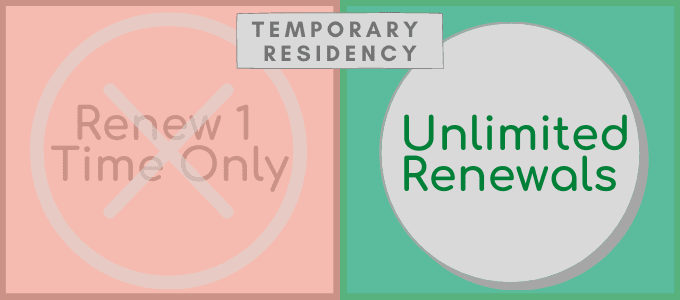





The temporary visa rules have been updated to allow for unlimited renewals. This applies to all temporary visa types such as the Professional, Investor, Rentista, Retirement, Volunteer, Student & Dependant.
This matters to those that are on the fence about whether they should take the next step and apply for permanent residency. This change effectively allows you to keep your temporary residency for as long as you like, provided you're ok with renewing it every 2 years.
If you're thinking about eventually becoming an Ecuadorian citizen, then it's still best to obtain permanent residency sooner rather than renewing your temporary residency a few times.
The fees for renewing your temporary residency are the same as your original application.
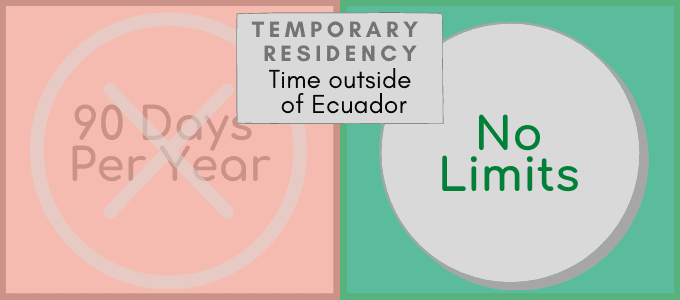





This visa change is a real bonus for digital nomads or anyone that works remotely from Ecuador.
The old rule limited temporary visa holders to a maximum of 90 days outside of Ecuador during each 12 month period.
So now, it's theoretically possible to visit Ecuador and apply for your temporary residency. Then once you've received your visa & cedula, you can leave the country for say 1 year, and then return and either renew your temporary residency or apply for permanent residency.
I'm not aware of many other countries that offer this level of flexibility during temporary residency, so this change alone could really help drive more visits from digital nomads or really anyone that doesn't want to be tied down in one location for too long.
This can also potentially give remote workers more ammunition to ask their current employer for permission to work from Ecuador as you now have complete freedom to spend as much or as little time in your head office.
If you really value your travel freedom, then perhaps continuously renewing your temporary visa every 2 years is the best option. Why? Because permanent resident visas still have a maximum of 180 days every year allowed outside of Ecuador.


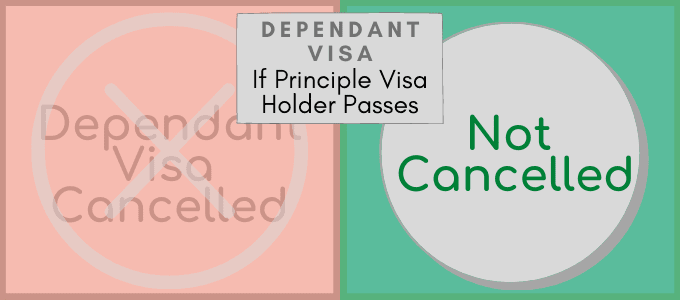





This update makes a lot of sense, especially given the difficult circumstances that dependants can find themselves in if they're no longer with the main visa holder.
For example, a common scenario for a married couple of retirement age is to move to Ecuador and apply for a retirement visa. But, perhaps only one person is eligible because they meet the social security income requirements. Then, the 2nd person could still apply as a dependant of the main visa holder. It's also considerably cheaper than applying for 2 retirement visas.
But, what if something then happens to the main visa holder? Perhaps they are in an accident and they pass away. What then happens to the dependant? Previously, this very difficult time was made even worse with the added stress of needing to figure out how they can legally stay in their adopted country. And, they only had 30 days to organize it or they'd need to leave the country. How stressful!
There still might be good reasons to apply for 2 individual retirement visas, so I'd consider using a visa facilitator before making this decision.
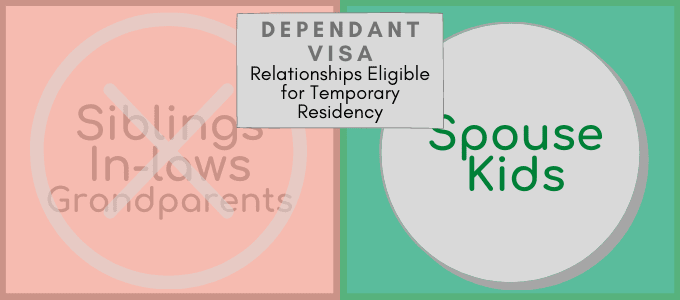





They've decreased the types of relationships that are now eligible for the dependant visa when applying for temporary residency.
The previous rule allowed for a wider range of relationships such as grandchildren, brothers, brothers-in-law etc that could obtain a dependant visa.
But now, you'll only be able to obtain a dependant visa for your:
Note, this is different from the rules for permanent residency which have not changed and still allow for wider relationships.
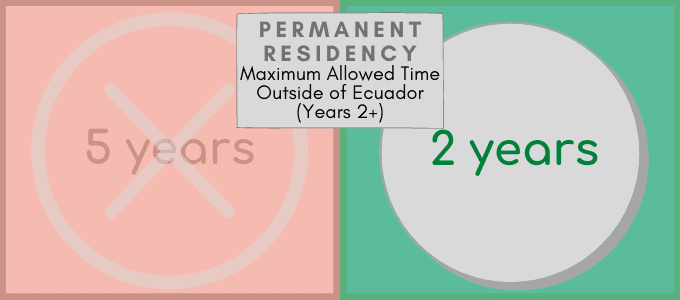





This update mainly affects those that spend little time in Ecuador, but still wanted to keep their options open.
The first 2 years of your permanent residency have also changed a little bit. You're still allowed a maximum of 180 days outside of Ecuador each year for your first 2 years. But, instead of being able to pay a substantial fine, you'll lose your permanent residency and need to start again with temporary residency.
But, the previous rule allowed for an incredible amount of freedom to spend time outside of Ecuador and still maintain your permanent resident status. You could basically just fly into Ecuador for 1 day, then fly out and then keep your permanent residency status for another 5 years. This clearly doesn't help the Ecuadorian economy, so I'm not super surprised that they've rolled this back to a more reasonable 2 years.
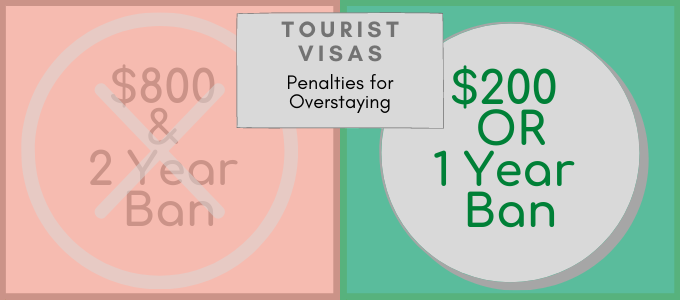





The catalyst for this rule change appears to be the many people that were effectively stranded in Ecuador during the COVID pandemic.
Many visitors on tourist visas could not leave the country and were forced to stay and then apply for tourist visa extensions. But, what happens once that 90-day extension expires? You either had to apply for a different visa or accept the $800 fine and the 2-year ban on entering Ecuador.
This new rule eases that burden on these visitors that have either:
They now have the option of accepting a one-year ban on entering Ecuador OR paying the $200 if they want to re-enter within the one-year period. The $400 fine will automatically be voided after one year.
I applaud the Ecuadorian government for using common sense and decreasing the fines for overstaying during the pandemic. Let's hope they don't increase the fines again anytime soon.


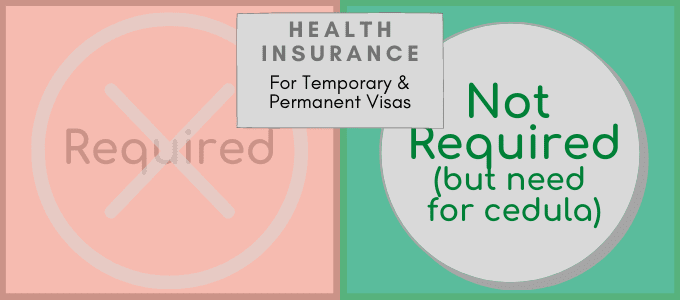





You should have health insurance whilst living in Ecuador. This can be either private or public (IESS).
Health insurance was previously a requirement before any temporary or permanent visa was issued. They've now gone away with that is, but have introduced a substantial caveat - you still need to have health insurance before they'll issue your cedula.
A cedula is like a driver's license that you carry everywhere with you and you'll quickly memorize your number because everyone asks you for it when you buy anything or do anything official like open a bank account.
You normally receive your Cedula after you've received your temporary residency. So, the effect on most applicants will be the same. You're going to need health insurance as you'll definitely want your cedula.
All of the preceding rule changes mentioned have now come into effect. The following is an anticipated rule change that is not yet in effect. We've been in contact with the Ministry (late March 2021), and they have confirmed that






The first 180 days in Ecuador are pretty straightforward for citizens from most countries. You obtain a tourist stamp when you enter which is valid for 90 days. Then, a Tourist Visa Extension is easily obtainable for another 90 days.
But, now what happens after these initial 180 days? You can apply for a temporary residency visa if you're ready. However, for many (myself included) it can take quite a while for you to even gather all of your documents, have them apostilled, and then finally sent to Ecuador.
In the meantime, your visa clock doesn't stop ticking, so it may be necessary to obtain some sort of bridging visa. The previous best option for this was the Special Tourist Visa. This visa was valid for 90 days, but you could only apply for it once every 5 years - which means it's really not practical to use it any more than once. This visa has now been repealed.
The new Commerce Visa is much more practical as it allows you to spend 180 additional days in Ecuador every year! I believe the 'commerce' requirements are pretty loose, but as it's a new visa it's still hard to say what activities will be eligible.
Wow, that is a lot of visa changes to comprehend. Do these changes affect you? Feel free to let us know in the comments below.
And, if you haven't checked out our Residency Visa Calculator, we suggest spending the next 30 seconds doing exactly that.
If you have any questions about these changes or are not clear about the visa requirements in general, feel free to reach out and we can put you in touch with our recommended visa facilitator.
We've been trying our best to answer your questions in the comments. But honestly, it's getting a little out of control. We're effectively giving free mini-consultations based on your personal circumstances. If you do value our work and would like to support us (and this site), please consider buying us a Coffee Tree for our family's eventual farm.
Note, providing a donation does not guarantee a response to your visa question, but it will provide a small additional incentive for us to do so. This token amount (it's only like $5+) is really just an acknowledgment of our work.
